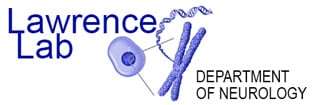The Lawrence lab’s research bridges fundamental questions about genome regulation with the clinical implications of recent advances in our studies of epigenetics. The genome is not a linear entity, but exists as a complex three-dimensional structure within a highly complex nuclear structure. A major focus of the lab has been to demonstrate and investigate the functional organization of human genes and RNAs within a highly compartmentalized nuclear structure. These interests motivated many years of work to develop new ways to visualize individual genes and RNAs directly within cell structure, particularly in nuclei and chromosomes. Compelled by a then new idea that gene and chromosome organization was a fundamental component of epigenome programming during development, we developed single-copy gene and nuclear RNA FISH technology, making it possible to map genes not only on chromosomes but within the interphase nucleus. This early work demonstrated that many “coding” genes and their pre-mRNAs are organized in specific domains or compartments within the mammalian nucleus. Further developing these approaches, we demonstrated that RNA from the XIST gene is expressed exclusively from the inactive X-chromosome and coats the structure of the interphase X chromosome territory, where it induces heterochromatin modifications which silence the chromosome. These studies were key in establishing the precedent that a large “non-coding” RNA had function, and XIST now remains the preeminent paradigm for RNA regulation of the epigenome and continues to be a focus for my lab’s research.
Beginning in about 2007, we began an ambitious project to translate discoveries in chromosome biology and epigenetics to a novel approach to correct a chromosomal abnormality, particularly trisomy 21 in Down syndrome. We were able to demonstrate that the very large XIST gene could be accurately targeted into one extra human chromosome 21 in iPS cells from a Down syndrome patient. Further, the RNA showed a robust capacity to repress transcription across the Chr21 bearing XIST. This paves the way for a number of new avenues for translational research for Down syndrome ongoing in our lab, including the investigation of specific cell pathologies and pathways directly impacted by trisomy in human Down syndrome stem cells (including stem cell derived organoids or “minibrains”) and in Down syndrome mouse models. This also now opens a new possibility: that trisomy 21 could be functionally corrected in specific cells by insertion of a single gene, XIST.
The ability of a gene from the X- chromosome to induce silencing of an autosome provides evidence that XIST RNA utilizes a genome-wide mechanism to induce heterochromatin and architectural changes that is shared across chromosomes. Thus, we are also exploring the implications that many repetitive sequences (often still considered simply evolutionary junk) may play a fundamental role in chromosome structure and function, and in shaping the human epigenome.




